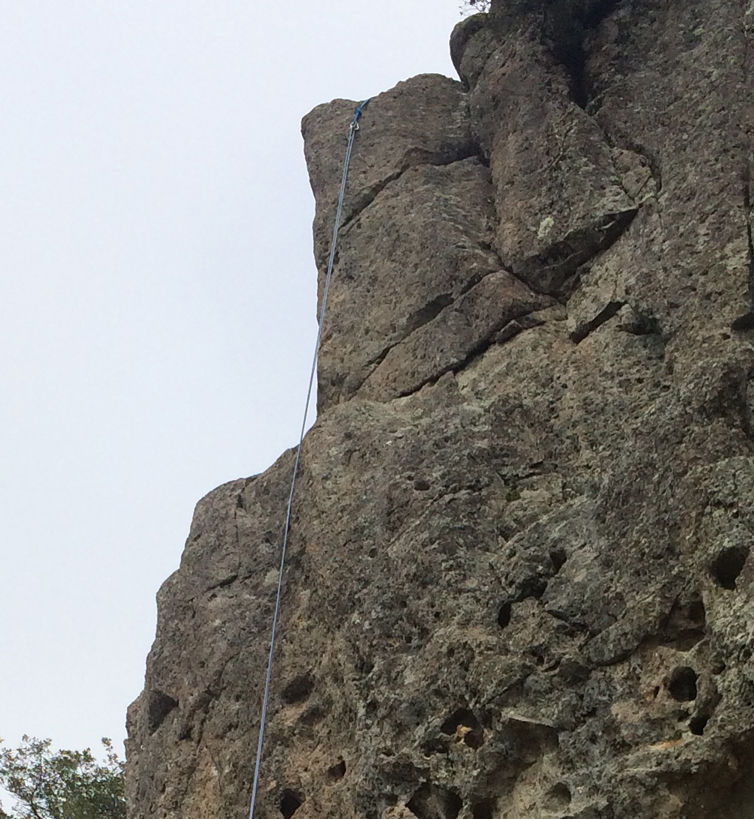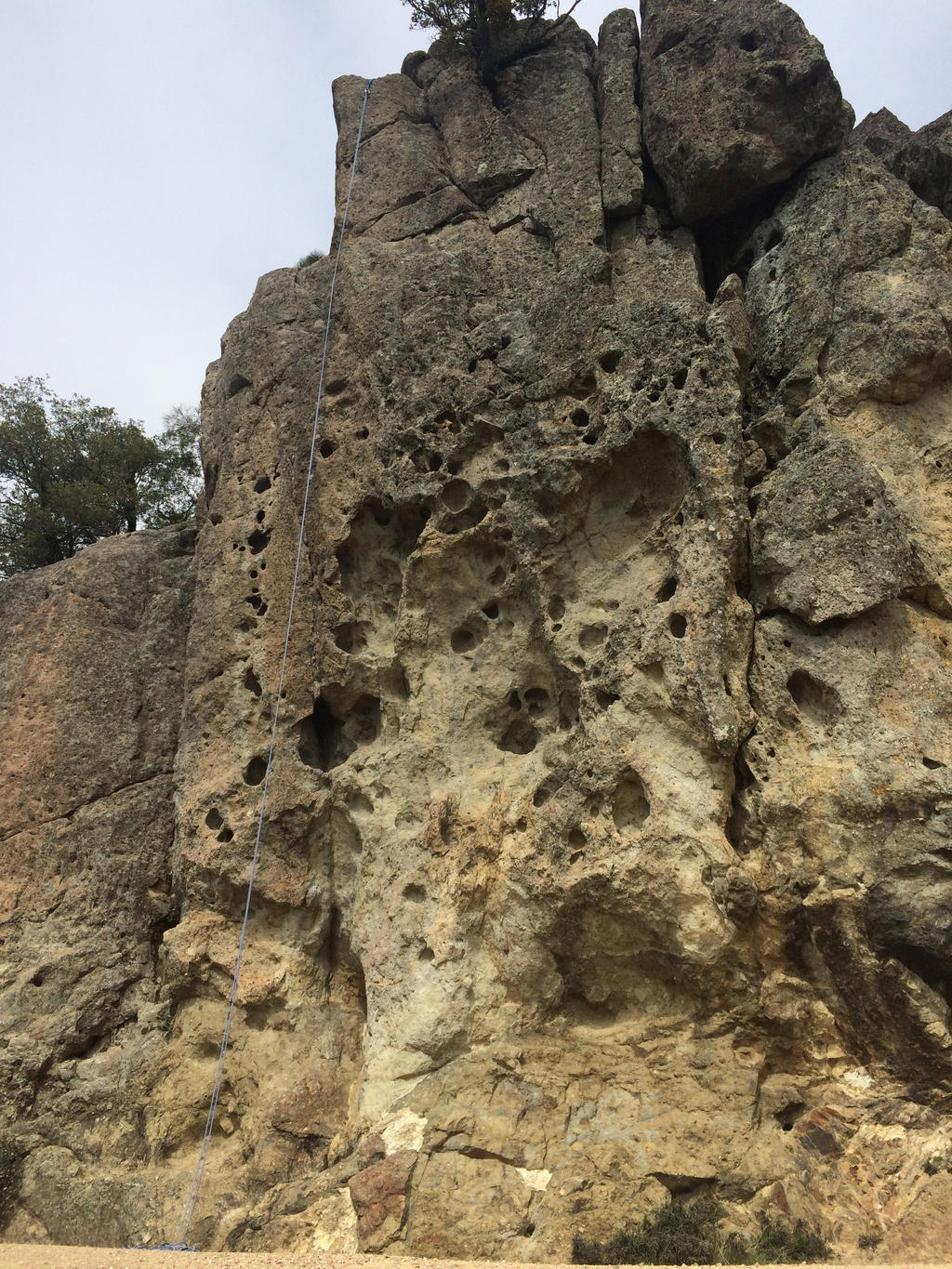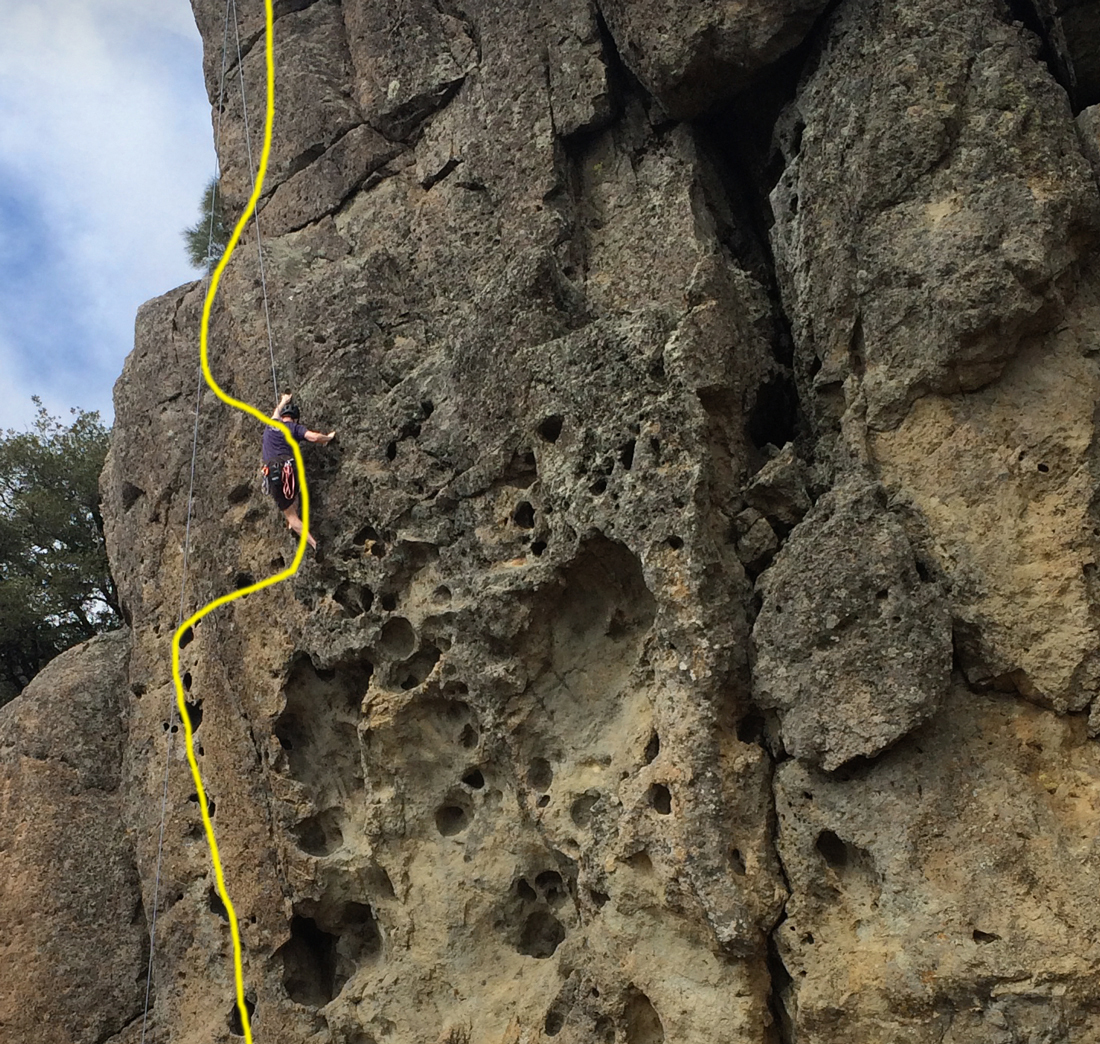Rope Drag on Route
|
|
This question is about a specific route I climbed a few weeks ago. It's "The Ladder" at The Bubble, Mt. Saint Helena, CA: mountainproject.com/v/the-l… Full size: img09.deviantart.net/c4c9/i… Full size: mountainproject.com/images/… |
|
|
I don't see any rope rub/drag issues at all in these photos. It's practically a straight shot to the biners. That ledge partway down? The rope barely bends as it passes there - no problem there. |
|
|
Gunkiemike wrote:I don't see any rope rub/drag issues at all in these photos. It's practically a straight shot to the biners. That ledge partway down? The rope barely bends as it passes there - no problem there.Oh, ok. Yeah, start at the anchor and trace down the line. That first ledge you come to. Maybe it's hard to see in the photo. But the rope is dragging over the rock for about 7 feet at least. If it looks ok, then sweet. No worries. I climbed it (that's me in the photo). But I assumed that much rope drag was a bad thing. |
|
|
FourT6and2 wrote:... the rope is dragging over the rock for about 7 feet at least. If it looks ok, then sweet. No worries. I climbed it (that's me in the photo). But I assumed that much rope drag was a bad thing.It sounds like you are defining the significance of the rope drag just in terms of the length of rope "on the rock." Is that right? And what do you mean by "bad thing" or "nasty" rope drag? What is your technical concern here? |
|
|
FourT6and2 wrote:But the rope is dragging over the rock for about 7 feet at least.Since I only climb easy stuff there's always some low angle rock or ledges that a top-rope will run over. While climbing it's not a big deal, but while being lowered there is more pressure. As long as it's not cheese grater rock or a sharp edge your rope should be fine. I pay more attention when I top rope solo, as the line is now fixed and the wear is concentrated in one spot. If there's a spot in the middle of the route like this I throw a rope protector there and move it when I climb past, replace it when I rap down. Long story short, the scenario in your photos looks fine from here. |
|
|
James T wrote: As long as it's not cheese grater rock or a sharp edge your rope should be finelol this was both of those things. The rock there is volcanic in nature and quite sharp. I had cuts all over my hands after climbing two routes. The edge of that lip on the ledge is equally sharp. That's why I was concerned about rope drag. Rope got torn up too. Not bad. But it struck me as excessive for the amount of climbing we did that day. |
|
|
The solution is not to top rope, not to lower and to only belay seconds from a top belay. Follow these simple steps and your rope will last 10x longer. |
|
|
Yikes - that does sound exceptionally sharp. |
|
|
FourT6and2 wrote: lol this was both of those things. The rock there is volcanic in nature and quite sharp. I had cuts all over my hands after climbing two routes. The edge of that lip on the ledge is equally sharp. That's why I was concerned about rope drag. Rope got torn up too. Not bad. But it struck me as excessive for the amount of climbing we did that day.I was looking at the photos and thinking it looked familiar -- happens I climbed there about 4 years ago; didn't do The Ladder, but did The Old Ladder just to the right. Yep, definitely sharp rock, though not the sharpest I've climbed. Some choices: as others have suggested, lead & top-belay; then rap off (or walk off) is going to be your best bet. If cragging somewhere that has sharp rock and/or a lot of abrasion, choose a rope with a higher percent of sheathe as compared to core, and prefer a thicker rope for more durability. |
|
|
For my own education here, how does a top-belay reduce rope drag on the climber's side of the rope in this specific circumstance? There wasn't any drag on the belayer's side since we weren't standing with our noses touching the rock—the belay side of the rope cleared the ledge. I understand how a top-belay can reduce drag through the actual anchor master point because it's not sling-shotting back down to the ground. But I'm more concerned with the climber-side rope running over the ledge. |
|
|
FourT6and2 wrote:For my own education here, how does a top-belay reduce rope drag on the climber's side of the rope in this specific circumstance? There wasn't any drag on the belayer's side since we weren't standing with our noses touching the rock—the belay side of the rope cleared the ledge. I understand how a top-belay can reduce drag through the actual anchor master point because it's not sling-shotting back down to the ground. But I'm more concerned with the climber-side rope running over the ledge. I'm not good enough to lead yet. So... one day haha. But leading/rapping certainly makes sense to me. The rope I have is the Mammut 10.2 Gravity.I follow your logic, and it's not super intuitive, but in practice it does usually have less drag. I think part of it is that you can keep less tension on the rope while still providing a safe belay. For example on a slingshot belay you need to keep it extra tight to prevent rope stretch from leading to a long toprope fall, plus any slack you leave in will be split between the belayer side and the climber side. Plus this is usually in the context of: lead, top belay, rap/walk off. The most important contribution here is no lowering, which introduces the most wear by far. But the leader will also experience less drag/rope wear because he or she doesn't weight the rope and also the rope is held farther away from the rock while climbing (tied into waist vs. anchored to surface of rock). |
|
|
Nathanael wrote: I follow your logic, and it's not super intuitive, but in practice it does usually have less drag. I think part of it is that you can keep less tension on the rope while still providing a safe belay. For example on a slingshot belay you need to keep it extra tight to prevent rope stretch from leading to a long toprope fall, plus any slack you leave in will be split between the belayer side and the climber side. Plus this is usually in the context of: lead, top belay, rap/walk off. The most important contribution here is no lowering, which introduces the most wear by far. But the leader will also experience less drag/rope wear because he or she doesn't weight the rope and also the rope is held farther away from the rock while climbing (tied into waist vs. anchored to surface of rock).Yes there's half as much rope stretch so you don't have to belay as tightly, but it's actually better to lead then top belay then rap/walk off because the rope never moves across rock while under tension. There might be some minor movement under tension that could produce wear during falls by the leader or maybe (less force, less movement) the second. The real reason it is better for your sheath is that you never lower. Lowering is what will destroy your rope as James T stated upthread. When your sheath damage occurred, was it over the entire length of the rope or was it isolated to one small area? If it's a small section, I'd say you rubbed that section while falling or working a move, if it's a longer section, you probably rubbed it while you were being lowered off the route. |
|
|
Eric Chabot wrote: Yes there's half as much rope stretch so you don't have to belay as tightly, but it's actually better to lead then top belay then rap/walk off because the rope never moves across rock while under tension. There might be some minor movement under tension that could produce wear during falls by the leader or maybe (less force, less movement) the second. The real reason it is better for your sheath is that you never lower. Lowering is what will destroy your rope as James T stated upthread. When your sheath damage occurred, was it over the entire length of the rope or was it isolated to one small area? If it's a small section, I'd say you rubbed that section while falling or working a move, if it's a longer section, you probably rubbed it while you were being lowered off the route.All of the visual "wear and tear" was on the section of rope attached to the climber's harness. That "half" of the rope, if that makes sense—the portion running over that ledge. In any event, when I climbed the route and got to that lower ledge, I saw a chain/anchor there. If you can set up a tope-rope anchor there, it would totally eliminate all the rope drag. The problem is... getting to that ledge. I guess you'd have to rappel down to it. Before we climbed, we guessed there must be another set of bolts there. But you can't see it from the bottom, nor the top. |
|
|
most will top rope from the chains on the ledge and extend an anchor for most of those climbs. you can walk to the ledge but it is a little exposed. |
|
|
splitclimber wrote:most will top rope from the chains on the ledge and extend an anchor for most of those climbs. you can walk to the ledge but it is a little exposed. I think it is because the last 15 feet above the ledge is hard and the crux and it is easier to set up multiple top ropes from the couple sets of anchors on the ledge. But you're probably only getting rope abrasion when you're getting lowered. I wouldn't use the term rope drag in this situation. Also, the pic you posted of yourself isn't really on the ladder, you are off to the right in between the "ladder" and "old ladder" route (lame name and confusing) which was bolted a few years ago and is 10a. But there are lots of ways to climb that face on top rope and on lead, which has resulted in a lot of confusion as to the ratings and "where to go" at the bubble.We tried getting to that ledge from the area where the west-facing routes are (solar power, etc.). But yeah... it's a dicey area. I might try to get to the chains next time and set an anchor there. The top part of the climb up to the top anchor is definitely much harder. But it went ok. As far as that photo, yeah that part of the climb is where I traversed over to the right a bit. I initially went straight up on the left. Although the guide book I have (Bay Area Rock) shows the route starting at the bottom toward the right more, going up the little roof, cutting left, going up straight along the corner, then traversing right after the 4th bolt. Then up a little, then a little S turn back to the left then up and right again to the top. So... whatever... haha all the routes are criss crossed. Here's the line I took: orig01.deviantart.net/548f/… |
|
|
FourT6and2 wrote:Additionally, after climbing this route. I got to that ledge and saw a chain attached to two more bolts sitting there. Can't see it from the top. Can't see it from the bottom. Maybe it's possible to rappel down to that ledge to set up an anchor there instead of at the top? But why would someone place an anchor that's only viewable while on the climb?It's not uncommon to see routes set up that way if the lower anchor allows for a better run to TR from below, but there is also a nice walk off located above. It's always interesting leading a route when you can't see the anchor until you get there :) |
|
|
Nick Drake wrote: It's not uncommon to see routes set up that way if the lower anchor allows for a better run to TR from below, but there is also a nice walk off located above. It's always interesting leading a route when you can't see the anchor until you get there :)haha yeah, it was like a little ah-hah moment while on the climb. We swore up and down... there has got to be a better spot to build an anchor for top rope. Then 3/4 of the way up the wall I see it lol. |

 Continue with onX Maps
Continue with onX Maps Continue with Facebook
Continue with Facebook























